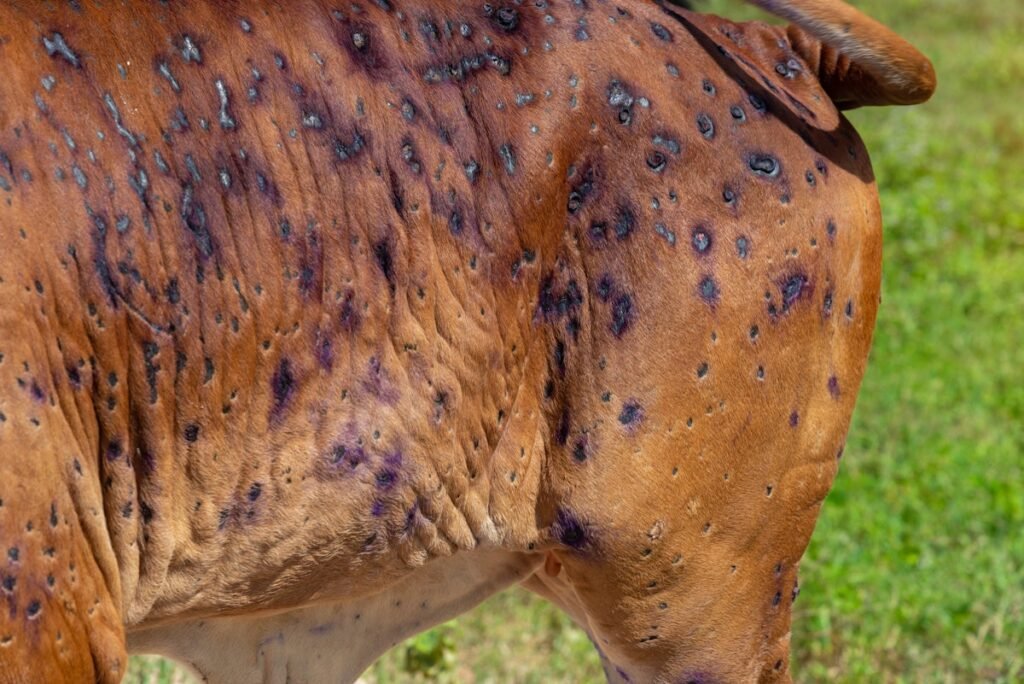Fresh Outbreaks Reported in Maharashtra
Lumpy Skin Disease (LSD), a highly contagious viral disease affecting cattle, has once again resurfaced in Maharashtra, with confirmed cases in Pune and Akola districts raising alarms across the dairy sector.
- Pune district: Over 900 cattle have tested positive, resulting in 15 deaths, while 591 animals have recovered, and nearly 300 are undergoing treatment. The worst-affected talukas include Shirur, Ambegaon, and Junnar.
- Akola district: Several villages have been placed under controlled zones, with a 10 km movement restriction, ring vaccination using goatpox vaccine, and suspension of cattle fairs to control the spread.
Authorities have mandated vaccination certificates for cattle transport, launched vector-control drives, and stepped up surveillance across nine talukas in Pune.
Clinical and Economic Impact
LSD causes nodular skin lesions, fever, lameness, reduced fertility, and sharp declines in milk production. Morbidity rates can range between 5% and 45%, while mortality, though lower, still has devastating effects on livelihoods.
The immediate economic impacts of the current outbreak are already visible:
- Reduced milk yields are expected in Pune and Akola, with producers reporting an average decline of 2–3 litres per cow per day.
- Cattle markets have slowed sharply due to movement bans, affecting farmers’ cash flows.
Looking Back: The 2022–23 Outbreak
The scale of India’s previous LSD epidemic offers a stark warning. Between July 2022 and March 2023, the disease spread to 24 states, infecting more than 3.6 million cattle and causing over 100,000 deaths.
A multi-state economic assessment estimated total losses of ₹202,544 crores (~USD 2.44 billion), with themost significantt costs stemming from:
- Milk yield reductions: Up to 74 litres lost per animal in Rajasthan, and 60 litres in Karnataka.
- Losses from hide damage, reduced draught capacity, and treatment expenses.
Milk supply shortages during this period led to regional price volatility, especially in western and northern states.
Vaccination and Control Measures
India now has access to two key vaccines:
- Lumpi-ProVacInd: Developed indigenously by NCVTC Hisar and IVRI, this vaccine has shown high efficacy and safety.
- Biolumpivaxin: Recently launched by Biovet in Karnataka, further strengthening the country’s preventive arsenal.
Authorities in Maharashtra have begun ring vaccination in affected areas, but complete immunity develops only 3–4 weeks post-vaccination, leaving herds vulnerable in the interim.
Prashant Tripathi, Dairy Economist, notes:
“The past outbreak showed how rapidly LSD can erode milk supply and farmer income. Proactive vaccination drives, vector control, and awareness campaigns are critical to avert the losses seen in 2022–23.”
Outlook for the Dairy Sector
- Milk production may dip further in Maharashtra and neighbouring states if the outbreak spreads beyond current hotspots.
- Consumer prices could firm up in affected regions, though the impact may be contained if vaccination coverage accelerates.
- Dairy cooperatives and private processors are likely to face supply disruptions in the short term, with potential effects on export commitments for value-added products.
Recommendations for Stakeholders
- Expand vaccination coverage aggressively in high-risk districts using Lumpi-ProVacInd and Biolumpivaxin.
- Strengthen veterinary infrastructure and deploy mobile clinics to reach remote villages.
- Intensify farmer education campaigns about early symptom detection, isolation, and vector control.
- Establish milk collection support schemes to stabilise farmer incomes during outbreaks.
